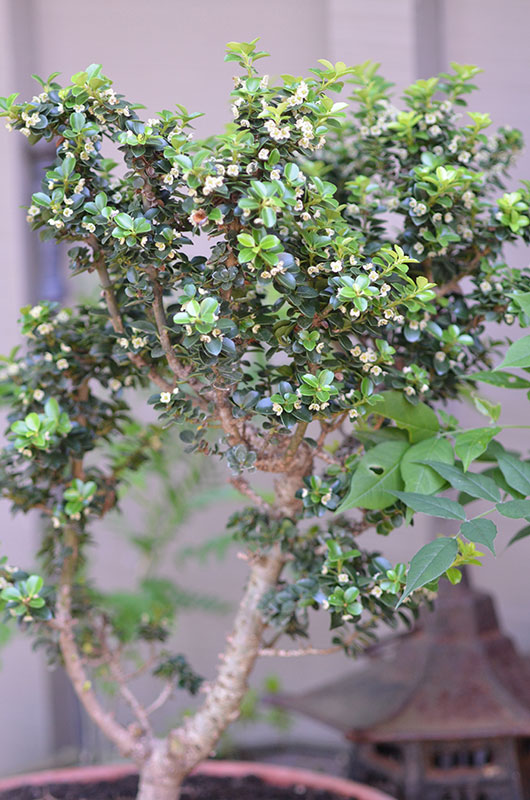Ilex crenata (Japanese Holly, Box-Leaved Holly)
Michael's Opinion
I. crenata is a commonly used hedge shrub that will grow as tall as it is wide. It is a specimen with great character for landscape and residential settings. Extreme pruning is endured due to the bark's strong structure making it an excellent topiary shrub. Winter protection is advised to maintain the plants health into the next season.
Botanical Information
| Family | Aquifoliaceae |
| Genus | Ilex |
| Species | crenata |
| Category | Woody |
| Type | Shrub (evergreen) |
| References | Dirr, Michael. Manual of Woody Landscape Plants. Fifth. Illinois: Stipes Publishing L.L.C., 1975. 458-461. |
| Origin | Ilex crenata is native to Japan. It was introduced to Russia in 1864 and the United States of America in 1898 by C.S. Sargent to the Arnold Arboretum. |
| Pronunciation |
Details
| USDA Hardiness Zone | 5a - 6a |
| USDA Hardiness Ref. | |
| Canadian Hardiness Zone | 6 |
| Canada Hardiness Ref. | |
| RHS Hardiness Zone | H6 - H7 |
| RHS Hardiness Ref. | |
| Temperature (°C) | -23 - (-18) |
| Temperature (°F) | -10 - 0 |
| Height | 1.5 m - 2 m |
| Spread | 3.25 m |
| Growth | Slow |
| Flowering Period | May, June |
Description and Growing Information
| General Description | Ilex crenata is a dense, compact shrub with multi-stemmed branches, dark green foliage and white flowers. |
| Shape | Upright, spreading. |
| Landscape | Use as a specimen in residential plantings such as foundations, hedges, borders and mass plantings. It can be ornamentally pruned and keeps excellent foliage. |
| Propagation | To propagate Ilex, cutting samples should be mature but firm, taken between July and September. It is best to retrieve 10 - 16 cm cuttings in the morning when the plant is well hydrated. Remove the leaves, douse bottom tips in plant hormone and plant half of each cutting in a pot filled with damp sand. Cover with a plastic bag and place in indirect light; keep the soil moist. When there is new growth, remove the bag and transplant into 1 gallon containers, allow to mature before transplanting outdoors. |
| Cultivation | Grow in full sun to part shade, in moist, well-drained, slightly acidic soil. Protect from dry winter winds. To promote plant vigour, prune after new growth has hardened off, it tolerates severe pruning. |
| Pests | Factors to consider are spider mites (which can create serious damage), nematodes and thielaviopsis blight. |
| Bark/Stem Description | Smooth, grey-brown tinged with green, mostly hidden in the dense canopy. |
| Leaf Description | Alternate, simple, broadly elliptic or obovate to oblong lanceolate, 0.5 - 1 ⨉ 0.5 - 1.5 cm, dull, flat to lustrous, dark green in colour. |
| Flower Description | Dioecious with four dull green-white petals, in 3 - 7 cymes (clusters with a central stem bearing a single terminal flower that develops first, the other flowers developing as terminal buds on lateral stems). |
| Fruit Description | Black, globose berries 50 mm in diameter are produced in September and October. Only female plants bear fruit which can be hidden under the foliage. |
| Colour Description | The foliage is a rich green, flowers are white with a dull green tinge and the bark is grey-brown. |
| Texture Description | Medium textured in all seasons. |
Photographs
Ilex crenata 'Fastigiata'

Ilex crenata 'Dwarf Pagoda'
Ilex crenata 'Korean Gem', RHS Garden Rosemoor, North Devon, England.
Ilex crenata 'Mariesii', RHS Garden Rosemoor, North Devon, England.
Ilex crenata 'Shiro-fukurin', RHS Garden Rosemoor, North Devon, England.
Ilex crenata 'William Jackson', RHS Garden Rosemoor, North Devon, England.